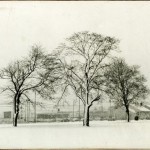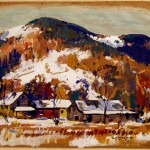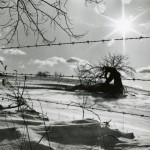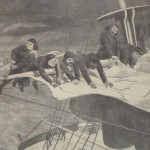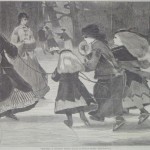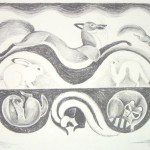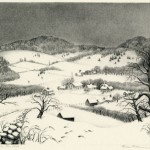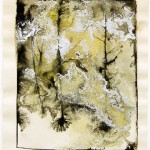Art & Poetry
The Thousand Words Project (Rhythms and Motifs), Joyce Pollard, 7th Grade Language Arts, Auburn Middle School
Connecting Art and Poetry
Send us a comment on this lesson
Overarching Goals
1. Students will demonstrate an understanding of how the artist builds a piece of art and the connection to building a piece of writing.
2. Students will focus on art that relates to winter and make connection to their own winter experiences.
Student Goals
1. Students will demonstrate an understanding literary devises used with poetry by identifying rhyme, rhythm, repetition, simile, metaphor and personification in poetry and by using those literary devises in student written poems.
2. After viewing different selections from the Bates collection relating to winter, students will write an original poem using some of the literary devises above to either describe the piece of art or to describe a personal connection/experience that relates to one of the art selections.
3. Students will create a classroom anthology of work.
4. Students will submit selections to Bates for the purpose of creating a 7th grade anthology with different selections from all the AMS teams.
Maine Learning Results
B. Literature and Culture: students will use reading, listening and viewing strategies to experience, understand, and appreciate literature and culture.
· B7: Apply effective strategies to the reading and interpretation of fiction including poetry.
E. Process of Writing and Speaking: students will demonstrate the ability to use the skill and strategies of the wiring process.
· E1; Identify specific personal strategies, strengths and weaknesses in writing, and use direct feedback from peers and teachers to revise and polish the content of their finished pieces.
· E2: Use planning, drafting, and revising produce on demand a well – developed, organized piece that demonstrates effective langue use, voice, and command of mechanics.
Revised Maine Learning Results
A. READING: Students read to comprehend, interpret, analyze, evaluate, and appreciate literary and expository texts by using a variety of strategies. They connect essential ideas, evaluate arguments, and analyze the various perspectives and ideas presented in a variety of literary and expository texts.
· A4: Reading Comprehension: Literary Text: Students describe how meaning is conveyed in poetry through diction, figurative language, repetition, and rhyme. Students identify types of poetry.
B. WRITING: Students utilize the writing process to express their ideas and experiences; to communicate information to others; to present or analyze an argument; and to participate effectively in academic, civic and economic communities.
· B1. Writing Process Students use the stages of the writing process to communicate effectively for a variety of audiences and purposes.
· B1 a-f: Students determine a purpose for writing.
· Students decide which information to include to achieve the desired purpose.
· Students revise drafts to improve focus and effect and voice, incorporating PEER FEEDBACK.
· Students edit for correct grammar, usage and mechanics.
· Students publish writing to achieve a specific purpose.
Pre-teaching Activities
1. Prior to viewing the art selections from Bates College, the students will review the specific literary devises used in creating poetry.
2. The students will be able to define the terms: rhyme, rhythm, repetition, simile, metaphor, personification and identify specific types of poetry.
3. Students will use images from https://www.bates.edu/x114427.xml to make connections between the literary devises and some of the images found on the Bates web page. Specifically, students will use the Dahlov Ipcar – Winter Image to view use of rhythm and repetition in art. Students may use the other artwork to learn to create metaphors and discuss how this adds meaning to poetry as well as to the paintings and photographs.
4. The students will also read published poems to look for these poetic devises, write and discuss how these devises convey meaning in the poem.
5. The students will create short poems that use sensory description and similes and or metaphors.
6. Students may be able to go outside to experience winter and write about or illustrate what they have observed.
Teaching Activities
1. The students will view different winter art selections from the Bates collection (scroll down).
2. The students will listen to the presentation that will describe the similarities of the painting and writing process.
3. The students will use their laptops to view the different styles of art presented on the web page https://www.bates.edu/x114427.xml and make comparisons of the different styles of art and photography presented.
4. The students will select one piece to start describing, and then proceed to use the writing process to add to their descriptions using poetic devices as a part of the process.
5. The students will select then decide the focus of their own poem – their poem may either describe the piece of art or relate a personal experience that connects to that piece of art.
a. The poem must include the use of similes or metaphors.
b. The poem must connect to the art.
6. Students will peer edit and teacher edit the rough drafts of the poem
7. Poems will be revised and typed for classroom publication.
8. Poems will be submitted to Bates College for review and selections may be included in an AMS anthology or works.
Classroom Publication
Poems will be shared both orally in an informal presentation, published in a classroom collection and posted on the school web site.
Assessment
- Quiz scores, quality of discussion and completion of the required assignment will assess pre-teaching activities.
- The final poem will be assessed on quality of work and meeting assignment requirements.Connection to other teaching units
Enrichment
This will connect with the subsequent unit of winter adventure stories and learning about survival skills (The Iditaread)
After you have finished using this TWP lesson with your students, please help us improve the program by responding to this short survey at https://bates.co1.qualtrics.com/SE/?SID=SV_2oikOibUWoOemsl
